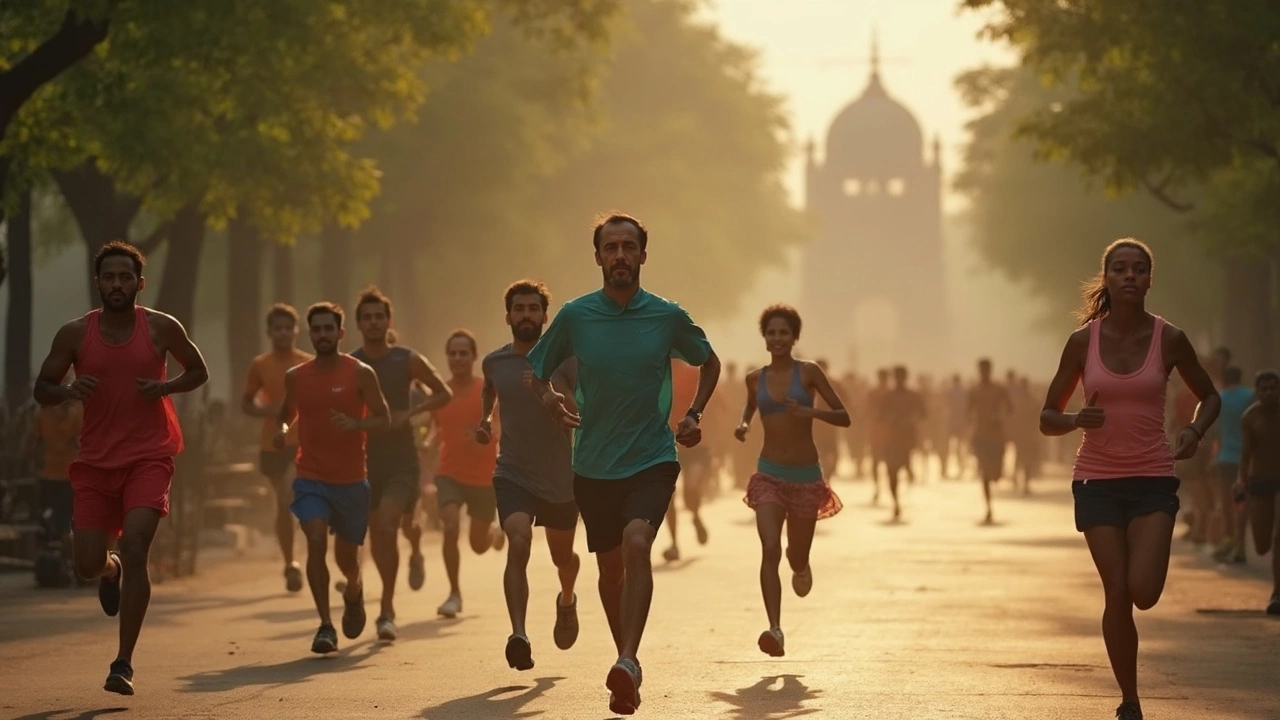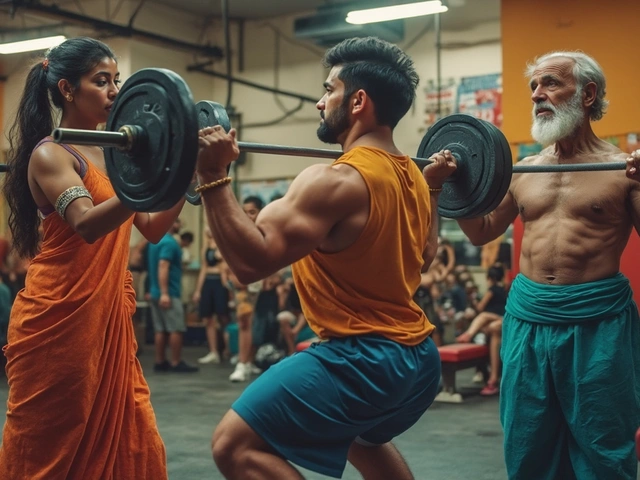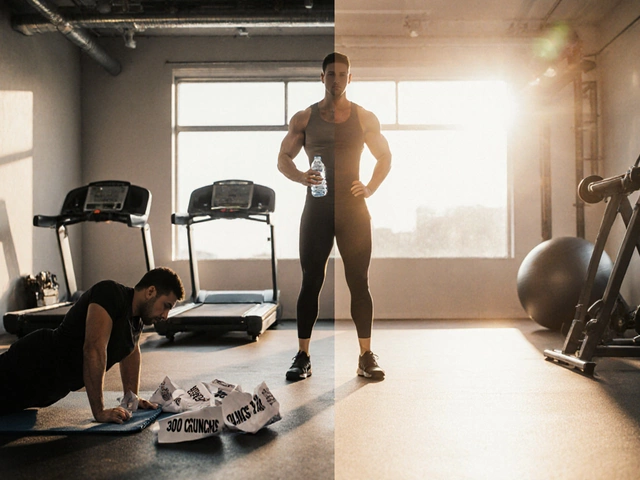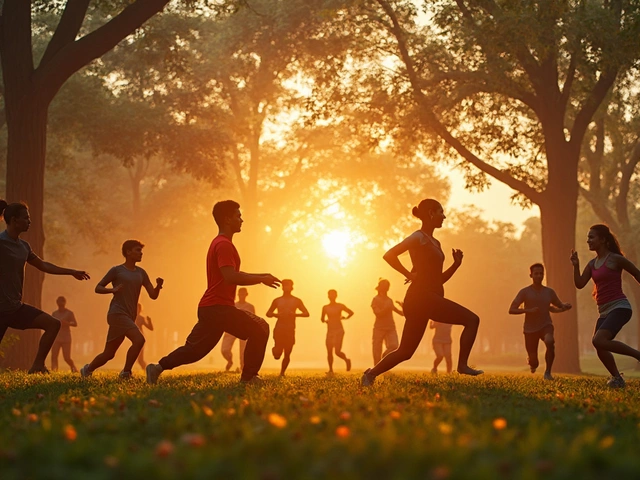Burning 1000 calories in a day is not as far-fetched as it sounds, especially if you're armed with the right workout game plan. The key? Combining different types of exercises to ramp up your caloric burn. Let's dig into some actionable steps you can take in the gym.
Starting with high-intensity interval training (HIIT) can be a game changer. HIIT workouts are known for packing a powerful punch in a short period of time. These workouts push your limits with repeated bursts of intense activity followed by rest or low-intensity periods. They're not just good at burning calories during exercise; they also elevate your metabolism for hours after you've hit the showers.
Don't underestimate the calorie-burning power of strength training. By building more muscle, you're increasing your resting metabolic rate—meaning you'll burn more calories even when you're Netflix-bingeing on the couch. Compound exercises like squats, deadlifts, and bench presses are particularly effective.
- Understanding Calorie Burn
- High-Intensity Intervals
- Strength Training Boost
- Cardio Kings
- Listening to Your Body
- Consistency Over Perfection
Understanding Calorie Burn
Ever wondered how our bodies transform sweat and effort into calorie burn? Let's break it down. At its core, burning calories is all about energy expenditure—how much energy you're using compared to how much you're taking in. To burn calories at an efficient rate, it's important to know about two types of metabolism: basal and active.
Basal Metabolic Rate (BMR)
Your Basal Metabolic Rate, or BMR, is the amount of energy your body needs to maintain basic functions like breathing and circulation while at rest. This is crucial because it accounts for about 60-75% of the total calories you burn every day! Your weight, height, age, and gender all play a part in determining your BMR.
Active Calorie Burn
Then there's the calories burned through activity. This includes everything from fidgeting while seated to crushing it on the treadmill. Vigorous activities burn more calories and get you closer to that 1000-calorie goal faster. For instance, a vigorous gym session can burn 500-700 calories per hour, depending on intensity and individual factors.
Factors Affecting Calorie Burn
Several factors can seriously affect your calorie-burning capabilities:
- Intensity of Workouts: Higher intensity usually equals higher burn.
- Muscle Mass: More muscle means more calories burned at rest.
- Age: Metabolism tends to slow down as you age.
- Environment: Temperature can play a part; exercising in a cold environment can increase calorie burn as your body works to maintain its core temperature.
Getting familiar with these aspects helps you tailor your gym workouts to maximize results. And remember, understanding your body's unique metabolic rate is key to efficiently achieving your fitness goals.
High-Intensity Intervals
High-Intensity Interval Training (HIIT) is a fantastic way to burn calories fast, fitting perfectly into your goal of cracking that elusive 1000-calorie mark. It pairs short bursts of hard effort with brief recovery periods, and the results can be impressive. But why does it work so well?
The magic of HIIT lies in the way it boosts your metabolism. After a good session, your body continues to burn calories at an accelerated rate, thanks to a process called Excess Post-Exercise Oxygen Consumption (EPOC). Basically, your body's working overtime to repair muscles and replenish cells.
How to Do a HIIT Workout
Getting started with HIIT doesn't require fancy equipment. Here's a simple outline you can try:
- Warm-Up: Spend 5-10 minutes getting your heart rate up with some light cardio like jogging or jumping jacks.
- Intervals: Pick a high-energy exercise like burpees, sprints, or mountain climbers. Go all out for 30 seconds.
- Rest: Take a 30 to 60-second rest, either by stopping completely or doing low-intensity activity like slow walking.
- Repeat: Aim for 5-10 cycles depending on your fitness level.
- Cool Down: Finish with a few minutes of walking and stretching to bring your heart rate down.
Examples of Effective HIIT Exercises
To keep your sessions fresh and exciting, try mixing up your exercises. Here are some to get you sweating:
- Burpees: This full-body move will get your heart rate skyrocketing.
- Sprint Intervals: Perfect if you have access to a treadmill or a track.
- Kettlebell Swings: Works your entire body and can be adapted easily to HIIT.
- High Knees: Simple, yet effective, and you can do them anywhere.
Remember, HIIT isn't about perfection. It's about pushing your personal limits and getting the most out of every second. So next time you're at the gym, give HIIT workouts a try, and see just how far you can push the calorie-burning envelope!
Strength Training Boost
When it comes to ramping up your workout, strength training is a powerhouse. It does more than just sculpt muscles—in fact, it’s one of the most effective ways to burn calories. Building muscle revs up your metabolism, helping you torch more calories even when you're not moving.
There are a few key strategies to make the most out of your strength workouts:
- Compound Exercises: These are your multitaskers in the gym workouts. Squats, deadlifts, and bench presses engage multiple muscle groups at once for maximum calorie burning.
- Progressive Overload: This means gradually increasing the weight, frequency, or number of repetitions in your strength routine. It challenges your muscles to grow and adapt, pushing your fitness to new heights.
- Supersets: This is all about efficiency. Alternating exercises without rest, like pairing pushups with rows, boosts your heart rate and overall calorie burn.
Strength Training Frequency
Working out at least three times a week with a focus on major muscle groups is a great starting point. If you're eyeing that 1000-calorie burn, aim for longer sessions or add in more sets.
For those who love numbers, here's a quick look at the extra calories you can burn with strength training:
| Weight (lbs) | Calories Burned/Hour |
|---|---|
| 125 | 180 |
| 155 | 224 |
| 185 | 266 |
Remember, the more muscle you have, the more calories you burn because muscle tissue is more metabolically active than fat. It's a win-win!

Cardio Kings
When it comes to burning calories, cardio exercises reign supreme. They get your heart pumping and can torch a hefty amount of calories quickly. So, what are the go-to options when aiming to hit that 1000-calorie burn target?
Running
Running is a classic calorie-burning activity. Depending on your pace and weight, you can burn anywhere from 600 to 800 calories per hour. For example, a 155-pound person running at a 6 mph pace burns about 372 calories in 30 minutes. Increase the pace, and watch those numbers climb!
Cycling
Hop on a bike, and you can burn around 600 calories an hour if you're cycling at a moderate speed. If you kick it up a notch with some high-intensity sessions, that number can rise significantly.
Rowing
Rowing is a fantastic full-body workout that can burn around 400 to 600 calories per hour. It's not just about the arms; your core, back, and legs get in on the action too.
| Activity | Calories Burned (per hour) |
|---|---|
| Running (6 mph) | 640 - 800 |
| Cycling (moderate) | 500 - 600 |
| Rowing | 400 - 600 |
Using Machines Smartly
Ellipticals and treadmills are great because you can adjust the intensity to match your desired calorie burn. Keep an eye on the digital readout—these machines often track the calories you're burning as you go!
If you're short on time, try mixing your cardio activities. A combination of cycling and running in one session can not only prevent boredom but also maximize your calorie burn by working different muscle groups. Remember, the goal is to get your heart rate up and keep it there for sustained periods.
Listening to Your Body
We often push ourselves in the gym by striving to burn calories, but it's crucial to remember our bodies aren't machines. They need rest, nourishment, and sometimes a break from the routine. Ignoring these signals can lead to burnout or even injury.
Rest and Recovery
First up, let's talk about rest. Though it sounds counterproductive when you're aiming to burn 1000 calories a day, rest days are vital. They're the time when your muscles repair and grow stronger, setting the stage for better performance next time you're in the gym. A good rule of thumb is to include at least one or two rest days each week.
Recognizing Overtraining
Are you sleeping enough, or feeling fatigued even with a whole night's rest? These could be signs of overtraining. Tune in to what your body is telling you. Elevated heart rate at rest, increased soreness, or getting sick more often can mean you're pushing too hard.
Adapting Your Workouts
Listening to your body also means adapting workouts when necessary. If you're nursing sore muscles, focus on low-impact workouts like swimming or yoga. These still keep the calorie burning up without pounding the pavement.
Remember, your body's energy needs will fluctuate, and hitting your goal of burning 1000 calories should be a marathon, not a sprint. Make sure to hydrate, fuel with nutritious foods, and get ample sleep.
Fitness isn't just about hitting numbers; it's about finding balance and what feels right for you.
Consistency Over Perfection
It's easy to get caught up in the quest for perfection when you're trying to burn calories at the gym. But here's the thing: perfection isn't necessary. Consistency is what truly makes the difference. It's about showing up regularly and keeping the momentum going, even on days when you don't feel like it.
Think about it—a single intense workout might make you feel great, but it's the routine of working out three to five times a week over months that really changes the game. Missing a workout here and there doesn’t spell disaster as long as you’re sticking with your plan more often than not.
Creating Habits
To stay consistent, focus on building a workout habit. Schedule your gym time as you would any important appointment and choose times that fit your lifestyle. Some research indicates that exercising in the morning increases consistency. Early workouts help avoid evening fatigue and reduce the likelihood of skipping due to unexpected plans.
Realistic Goals
Setting realistic goals is crucial. Rather than fixating on burning exactly 1000 calories every single day, aim for a sustainable workout that systematically increases strength and endurance while burning calories. Consider tracking your progress with a fitness journal or app to keep yourself motivated and accountable.
Focus on Progress, Not Perfection
Finally, celebrate the small victories. Maybe you've lifted heavier weights this week or shaved a minute off your treadmill time. These are the signs of real progress. Remember that fitness is a lifelong journey, and the results might not come overnight, but they will come. Consistency beats perfection every time.





